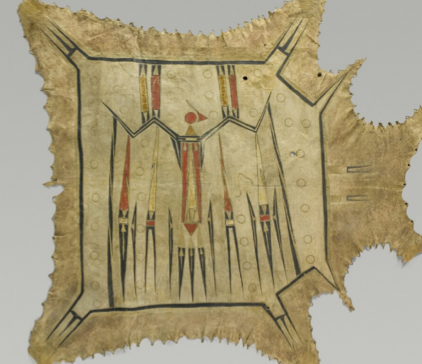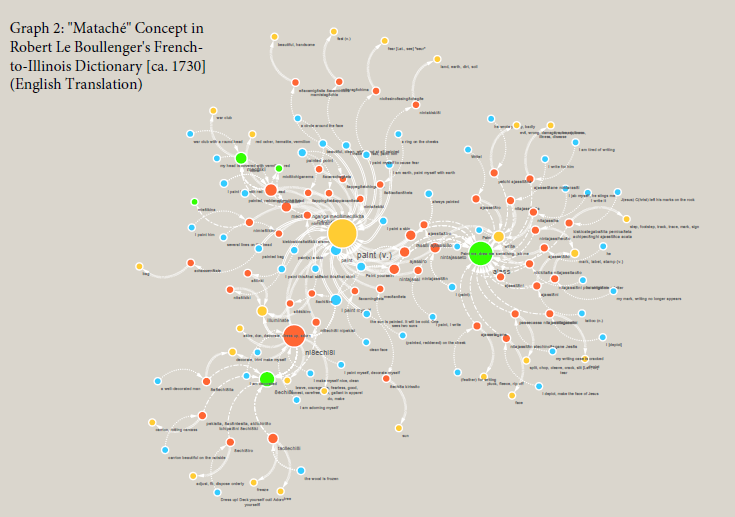Materials, Methods, Communities: Digital Methods and Early American Indigenous Histories
Download workshop slides and files here.
My goal in this workshop is to offer insights into how digital methods of scholarship and analysis have informed my contributions to recent collaborative work with communities. Much of my writing is on early Indigenous history and environmental history of the North American Midwest, and I have conducted a good deal of single-author research, including digital research, in this area over the years. In this workshop I aim to explain how this work has enabled me to contribute (modestly) to ongoing cultural revitalization work with members of the Peewaalia and Myaamia Nations, especially in a major project called “Reclaiming Stories.” Focused on traditional hide painting history and practice, the Reclaiming Stories project creates an opportunity for artists and knowledge-makers in these communities to reconnect with their ancestors’ ancient artistic works, even as they revitalize the practices of hide painting and tattooing today.

In this workshop I explain some of my own experiences with “tooling up” and becoming expert in some techniques of DH over the years. In particular, I highlight my journey in learning exploratory data science and exploratory network analysis methods which are two skill sets I have found especially useful for recovering histories from below. While this workshop is too short for me to fully instruct in the ways and means of these methods, what I do want to impart is the intuition behind the methods, as well as a sense of how these explicitly exploratory skills have allowed me to contribute to ongoing community work, for instance in the form of a kind of linguistic semantic analysis and visualization. We’ll look at a few datasets that hopefully will make this intuition visible and meaningful. The key insight here is that our DH methods are very good at certain kinds of tasks– categorizing, clustering, comparing, and classifying– that can be quite useful for the project of recovering meaning and historical experience, especially in certain specific kinds of archival traces.
I want to stress that my work with the Miami and Peoria communities is in a kind of “support” mode. As I’ll explain, it is tribal knowledge-makers whose ideas and creativity and expertise– not to mention goals– are centered in Reclaiming Stories. My own insights are limited by positionality and many other factors. Moreover, the scholars at the Myaamia Center are by far the more competent digital humanists in our team, as their extraordinary digital projects reveal (many Myaamia Center digital history publications are available on the website Aacimotaatiiyankwi).

But this is not to say that technical analysis by a cultural outsider and academic like me cannot contribute. Certain analytical techniques make it possible for me to add something to the conversation. As I’ll try to show, the application of these “naive” methods to rich questions of cultural meaning can play a role in unlocking complex history. (It is a fun irony that some analytical methods– “naive bayes” e.g.– literally have that word “naive” in their names). Meanwhile, I have worked really hard to develop a critical historians’ perspective and sensibility. I am not totally naive, and own journey has allowed me to understand– from an outsider perspective of course– much about what these techniques can and can’t tell about long-ago Indigenous histories and culture. Recognizing the limits of these insights is of course important; but it has also been important and very meaningful to add my own academic tools as one one component of what Miami Cultural Resource Officer Julie Olds has called our collaborative “searching” in these old archives.
Below I’ve included some links to materials we’ll talk about and work with in the course of the workshop.

About Me
Bob Morrissey is a historian of early American and environmental history at the University of Illinois Urbana-Champaign with deep interest in multiethnic digital humanities, particularly in his writing about Indigenous and French settler communities of the pre-modern midwest. Across several projects– from network analysis of 18th century interracial kinship patterns to collaborative work on art and history among Peoria and Miami communities— he uses DH methods in part to unlock Indigenous stories in colonial archives. His recent works include a new book “People of the Ecotone: Environment and Indigenous Power at the Center of Early America,” soon to be out from University of Washington Press.
Links and Resources
“Facebook Kaskaskia” Links
My first publication using exploratory network analysis was in the William and Mary Quarterly in 2011. It was a first attempt to “unlock” the histories of Indigenous actors in the French colonial archives of the pays des Illinois. In particular it was an exploration of Indigenous women’s participation in baptismal and marriage networks in relationship to a common understanding of those relationships’ meaning and function.
UCINET Software Package: http://www.analytictech.com/archive/ucinet.htm
Final Paper: https://www.jstor.org/stable/10.5309/willmaryquar.70.1.0103#metadata_info_tab_contents
Find project files and data here.
Archives of Connection Project
This was a methodological essay focused on the uses and potentials of network analysis for social history. I was coming to understand the uses of network visualization as a research method, although I had yet to think of it in terms of “exploratory” network analysis.
“Archives of Connection” essay, 2015. https://www.tandfonline.com/doi/full/10.1080/01615440.2014.962208
Generations of Jesuits Project
Here is an exploratory network analysis focused on the Jesuit missionaries who spent any amount of time with Indigenous Illinois communities at three mission centers in the pays des Illinois, 1672-1780. Since I was studying language acquisition and linguistic ability among these priests, I wanted to get a sense for the history of their careers as a way of critically evaluating what they wrote and the language materials (esp dictionaries) that they created. This visualization allowed me to understand certain things about the longevity of these individuals’ careers and relationships, both among themselves, and with Indigenous communities.
This work was never included in any publications but it informed ongoing research in this theme of linguistic analysis and history. For some writing on this theme see my essay, “‘I Speak it Well'”: Language, Cultural Understanding, and the End of a Missionary Middle Ground in Illinois Country, 1673—1712.“
Datasets and visualizations here.
Exploratory Data Analysis Project on Presidential Inaugurations
I took a major step forward with exploratory data methods in Spring 2017, when I was lucky to take a course with Ted Underwood, an extraordinary lit scholar at U of I. Reflecting the can-do mentality of DH in those years, Ted was generously willing to help me conceptualize the adaptation of exploratory methods to historical questions on a modest scale.
Below is my final project for our course “Data Sciences in the Humanities” in Spring 2017. What I especially came to understand in this course were clustering and classifying methods that rely on predictive modeling, or expected frequencies. Such algorithmic analysis provides an extraordinary toolkit that is “naive” and potentially very helpful.
GitHub Repository for the Presidential Inaugural Addresses Project: https://github.com/historybman/EADA
Final Essay for the Inaugurations Project: https://github.com/historybman/EADA/blob/master/essay/essay.md
Applying these Insights and Intuitions to Reclaiming Stories
The Reclaiming Stories project is a collaboration among tribal scholars, cultural education leaders, artists, and academics who are dedicated to the study of early Myaamia and Peewaalia art history and practice, especially hide painting and tattooing. The work is connected to– indeed it is a chapter in– an extraordinary process of cultural reawakening and revitalization among these Indigenous communities over the past two generations. At the heart of this revitalization story is the Miami-Illinois language, which has been reawakened through the work of linguists and experts at the Myaamia Center at Oxford, OH. This language work is the centerpiece of a robust community education program at Myaamia Center and at Miami and Peoria Tribal Headquarters.
The language work by the Miami Tribe included the creation of an extraordinary digital project, the Indigenous Language Digital Archive. I apply exploratory digital methods to this archive, as in the example of hide painting vocabulary that we will discuss. While the results are impressionistic, it is clear to me that digital methods help us enhance our understanding of the language archive, clearly the most important window into the meanings and practices we are interested in. In my view, what we “see” with these methods are clusters of meaning and conceptual relationships that unlock aspects of the sources in new ways.
Cytoscape Network Analysis visualizer: https://cytoscape.org/
Reclaiming Stories Project Website
Indigenous Language Digital Archive: Miami-Illinois.
Files for my linguistic analysis here.

Box Folder with Workshop Materials
Please find all workshop materials in this public Box Folder.